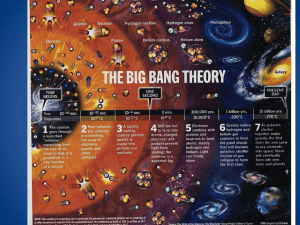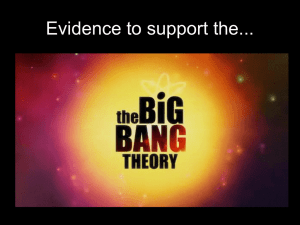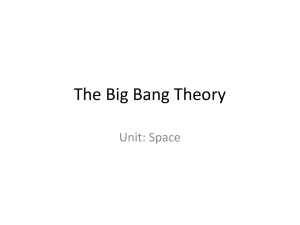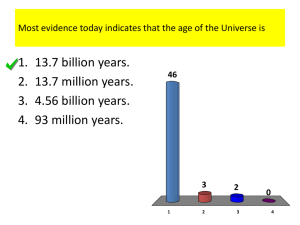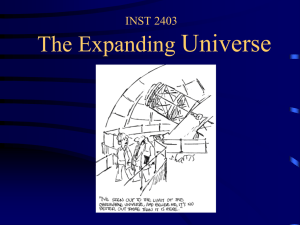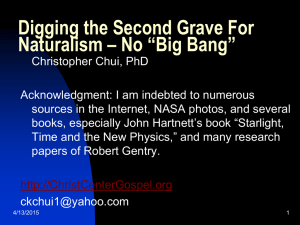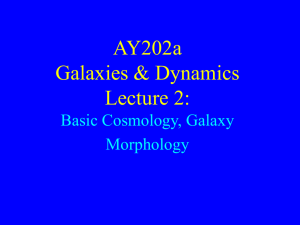big bang theory
advertisement
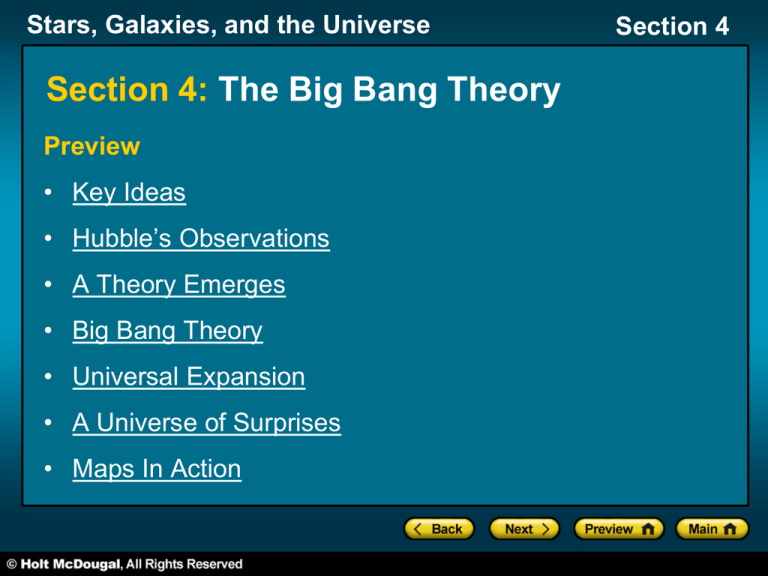
Stars, Galaxies, and the Universe Section 4: The Big Bang Theory Preview • Key Ideas • Hubble’s Observations • A Theory Emerges • Big Bang Theory • Universal Expansion • A Universe of Surprises • Maps In Action Section 4 Stars, Galaxies, and the Universe Section 4 Hubble’s Observations • cosmology the study of the origin, properties, processes, and evolution of the universe • Cosmologists and astronomers can use the light given off by an entire galaxy to create the spectrum for that galaxy. • Edwin Hubble used galactic spectra to uncover new information about our universe. Stars, Galaxies, and the Universe Section 4 Hubble’s Observations, continued Measuring Red Shifts • Hubble found that the spectra of galaxies, except for the few closest to Earth, were shifted toward the red end of the spectrum. • Hubble determined the speed at which the galaxies were moving away from Earth. • Hubble found that the most distant galaxies showed the greatest red shift and thus were moving away from Earth the fastest. Stars, Galaxies, and the Universe Section 4 Hubble’s Observations, continued The Expanding Universe • Using Hubble’s observations, astronomers have been able to determine that the universe is expanding. • The expanding universe can be thought of as a raisin cake rising in the oven. If you were able to sit on one raisin, you would see all the other raisins moving away from you. • Similarly, galaxies in the universe are moving farther away from each other due to the expansion of the universe. Stars, Galaxies, and the Universe Section 4 A Theory Emerges • Although cosmologists have proposed several different theories to explain the expansion of the universe, the current and most widely accepted is the big bang theory. • big bang theory the theory that all matter and energy in the universe was compressed into an extremely small volume that 3 to 15 billion years ago exploded and began expanding in all directions • By the mid-20th century, almost all astronomers and cosmologists accepted the big bang theory. Stars, Galaxies, and the Universe Section 4 A Theory Emerges, continued Cosmic Background Radiation • cosmic background radiation radiation uniformly detected from every direction in space; considered a remnant of the big bang • Astronomers believe that cosmic background radiation formed shortly after the big bang. • The background radiation has cooled after the big bang, and is now about 270 °C below zero. Stars, Galaxies, and the Universe Section 4 A Theory Emerges, continued Ripples in Space • Maps of cosmic background radiation over the whole sky look very smooth. But on satellite maps that show where temperatures differ from the average background temperature, “ripples” become apparent. • These ripples are irregularities caused by small fluctuations in the distribution of matter in the early universe. • The ripples are thought to indicate the first stages in the formation of the universe’s first galaxies. Stars, Galaxies, and the Universe A Theory Emerges, continued Timeline of the Big Bang Section 4 Stars, Galaxies, and the Universe Big Bang Theory Click below to watch the Visual Concept. Section 4 Stars, Galaxies, and the Universe Universal Expansion Click below to watch the Visual Concept. Section 4 Stars, Galaxies, and the Universe Section 4 A Universe of Surprises Dark Matter • Analysis of the ripples in the cosmic background radiation suggests that the matter that humans, the planets, the stars and the matter between the stars makes up only 4% of the universe. • About 23% of the universe is made up of a type of matter that does not give off light but that has gravity. This type of matter is called dark matter. Stars, Galaxies, and the Universe Section 4 A Universe of Surprises, continued Dark Energy • Most of the universe is made up of an unknown material called dark energy. • Scientists think that dark energy acts as a force that opposes gravity. Many scientists think that some form of undetectable dark energy is pushing galaxies apart. • Because of dark energy, the universe is not only expanding, but the rate of expansion also seems to be accelerating.
